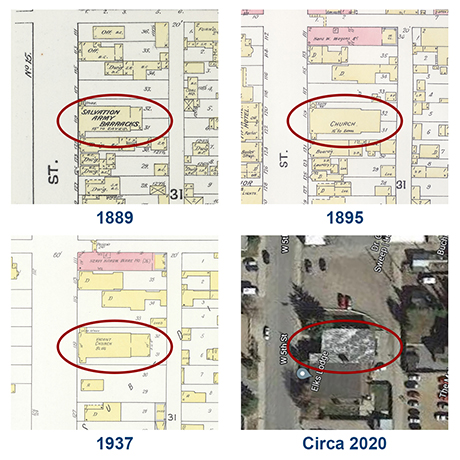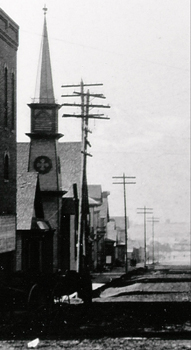Reflecting the trend of the times, the first group of Jews to settle in Leadville could trace their roots to Germany. They tended towards assimilationist attitudes and the practice of Reform Judaism. This included services largely in English, women as members of the congregation, and the use of a choir. Later immigration to America and Leadville included a large proportion of Eastern European Jews who were more rigorous in their religious observations and practices. As in other Jewish communities, this led to a bit of a schism.
In 1892, the congregation split with the more orthodox members electing to establish their own congregation, Kneseth Israel. In 1893, they occupied the former Presbyterian Church at 119 West 5th Street. The building survived until 1937 when it was razed to build an Elks Lodge [12]. Rabbis were generally unavailable to Temple Israel, but lay leaders continued to hold regular services until about 1908 [13]. The decline of the Jewish population in Leadville fundamentally reflects the weakness in the Colorado mining industry after America's abandonment of the silver standard in 1893. However, the more aggressive members of the community had already decamped to greener pastures during the late 1880s. David May's move to Denver in 1887 typifies this pattern of Jews gravitating towards larger cities. During the Thirties, the congregation dissolved entirely and the furnishings were allegedly transferred to the Hebrew Educational Alliance in Denver.
Leadville’s Orthodox congregation, Knesseth Israel, formed as a result of differences in worship philosophy and practice with the existing Leadville congregation. The reform congregation based at Temple Israel revolved around distinct American Jewish reform principles. The orthodox disagreed with these fundamentals. Accounts point to these three points of disagreement which fostered the separation:
- the use of choral and pipe organ music during services;
- gender integrated prayer; and
- methods of commemoration of the dead. [1]
The first mention of separate services appears in a Leadville Daily/Evening Chronicle article from October 9, 1886. That year Yom Kippur services took place at both Temple Israel under the reform congregation and “City Hall” under the Orthodox congregation. City Hall was a communal building that hosted many public events in early Leadville and was located on the 100 Block of East 6th Street. It burned to the ground in 1916. [2] The old Armory Hall, or Turnverein, across Pine street from Temple Israel also held Orthodox services in the late 1880s and early 1890s. By 1892 the congregation had purchased and moved into the old Presbyterian Church on West Fifth street.
Details of the separation of the Orthodox from the reform congregation is varied. In the History of Leadville and Lake County, the story of Knesseth was remembered with the following, “…A footnote to the story [Ben Davies scandal] [3] was told by Raabe children who claimed that after they and their mother returned from Europe in 1893, their parents decided to start attending services again at Temple Israel. The first time they went, not one member in attendance would speak to them, even though some of the congregation patronized the family business. Moreover, three years earlier dissension had arisen with the Temple Israel congregation as to how the worship services should be planned and conducted. Since a satisfactory compromise could not be reached, the orthodox members organized the Kneseth Israel congregation during the summer of 1892 and met in homes of various members for the next few years.
Prior to the Panic of 1893, the Salvation Army sold its barracks, 119 West Fifth Street, to the Orthodox Jews on October 18, 1892. It will be recalled this building had been the first house of worship for Leadville’s Presbyterians. It had come under the ownership of William Evans who had leased it to the Salvation Army. After the members of the Kneseth Israel congregation purchased the barracks, they converted it into a synagogue…” [4]
According to Alan Breck of The Centennial History of the Jews of Colorado the Orthodox congregation split away from the Reform due to disagreements about “…the lack of proper ritual, particularly in the commemoration of the dead… on August 28, 1892, they formed Kneseth Israel”. By late summer of 1892, the organization was in its beginnings. The first officers of the congregation were D. L. Rachofsky, Louis Greenwald, Jacob Bergman [5] , J. Hurwitz [6] , Joseph Tobolowsky [7] , and Zundel Greenwald [8] . Membership probably did not exceed 30 at Knesseth. The building that would house their new devotions was still occupied by the Salvation Army for most of 1892. It had been originally built in 1880 as the first Presbyterian church in Lake County. By November, the congregation was interested in a permeant headquarters and bought the old Presbyterian Church at the beginning of the month (see endnote 8).
The below graphic shows the Orthodox synagogue building loction at four years.
1889: The building was the Salvation Army Barracks and was previously a Presbyrerian church.
1895: The building became the Orthodox Synagogue.
1937: The previous religious building is vacant. The building was torn down after this date.
2020: Today, the land and surrounding plots are part of the Leadville Elks lodge.

The Knesseth Israel building in 1889, 1895, 1937, and circa 2020.
Courtesy of Sanborn Fire Insurance maps and Google Maps.
1 Breck, The Centennial History of the Jews of Colorado, p. 136-137
2 “Memories of Old City Hall” Herald Democrat, April 3, 1916 p 6
3 For more information on Davies, see http://www.jewishleadville.org/davies.html
4 Griswold and Jean Harvey Griswold, History of Leadville and Lake County, Colorado, p. 2108
5 For more information on Bergman, see http://www.jewishleadville.org/bergman.html
6 This is likely a misspelling of Harwitz. For more information on Harwitz, see http://www.jewishleadville.org/harwitz.html
7 For more information on Tobolowsky, see http://www.jewishleadville.org/tobolowsky.html
8 For more information on Greenwald, see http://www.jewishleadville.org/greenwald.html
12. Exploring Jewish Colorado, Phil Goodstein, University of Denver, 1992. P. 125.
13. The Centennial History of the Jews of Colorado 1859-1959, Allen duPont Breck, The Hirschfeld Press, 1960. P. 133.
Bibliography
xxxxxxxx
To cite any of the information in this biography, please use the following reference.
xxxxxxxx





